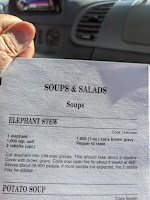Yes, it has been a long time since I've written - but, oh my goodness, we have been busy. And during that busy-ness, we've been clicking off more and more sites and activities on our way to completing our 70-new-things-in-our-70th-year-quest. This blog post is going to focus on what we found in Arthur, Nebraska - an absolutely wonderful stop on our way from Boulder to Petoskey this Autumn.
Arthur, Nebraska, population 118, was founded in 1913 and named after President Chester A. Arthur. Why did we stop there? Plenty of good reasons! Two, yes TWO, items for our 70/70 quest AND a public park with free camping with electric hookups AND a clean public restroom right across the little road from the campground. Fantastic! (And seeing how Arthur is pretty darned far from any other towns with camping, very much a relief to find the campsites open and available!)
The two items for our 70/70 quest? Two buildings in the National Historic Registry!
- #51: The Arthur County Courthouse and Jail complex, built
in 1914-15, is said to be the smallest courthouse ever built in the United
States. We had no problem finding it since it faced the block where we camped.
As an added attraction for the courthouse, a committee of turkey vultures was settled in the tree overlooking the courthouse.

- #52: The Pilgrim Holiness Church, built in 1928 out of straw bales. Why straw bales? Straw bale construction came in very handy during those days because of the lack of wood in the area and, because of Arthur’s location in the Sandhills of Nebraska, the local soil was not suitable for sod-based construction purposes. It is the oldest known straw-bale church in North American and one of only three known to exist today. Arthur’s church was constructed with stacked and baled hay creating walls two feet thick. It is thought that “gumbo mud” was originally used to plaster the walls inside and out; now the walls are stuccoed on the outside and plastered on the inside. Using baled hay for construction became possible in the 1850s with the invention of a mechanical hay baler. (Note: the first documented use of hay bales in construction was for a schoolhouse in the 1890s – a building that was unfenced and unprotected by stucco and plaster. In 1902 it was reported to have been eaten by cows.)
Beyond the historic landmarks, the people we met were delightful, the neighborhood inviting, and the camping cozy (good thing - the evening brought more turkey vultures plus we were serenaded by coyotes during the night).
To cap it all off, in the morning we visited the general store and discovered a treasure! The Arthur County Cookbook created by "Members of District #32 - Upper Room." And inside this cookbook, a Most Amazing Recipe!







No comments:
Post a Comment